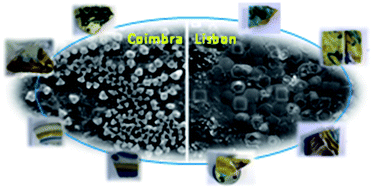Morphological and compositional features of blue and yellow pigments used in Portuguese glazed ceramics by SEM/EDX – unravelling manufacturing differences
Abstract
Morphological and compositional features regarding blue and yellow pigments used in glazed ceramics from Portugal are investigated by means of a SEM/EDX system. Fragments of samples produced in the main pottery-making centres between the XVI–XVIII centuries (Lisbon and Coimbra) were the objects of study. The main question to be answered is whether there are differences in the manufacturing procedures employed. For this purpose, two types of samples were analysed: faiences and wall-tiles (the famous “Azulejos”, in Portuguese). Differences between the manufacturing techniques of the two production centres were veritably found. The expected linkage between Fe–Co–Ni–As–Bi was challenging to investigate. Thus, Co was found in Fe- or Ni-rich structures, but with no structural connection to As or Bi. However, the As-needle-like structures were always identified in blue regions. One interesting finding related particularly to the blue pigment was the presence of SnO2 agglomerates throughout the whole glaze, which suggests its intentional addition for “lightening” the well known dark Co blue. Concerning the yellow pigment differences established in the crystal shape and size are indicative of different firing temperatures used.


 Please wait while we load your content...
Please wait while we load your content...